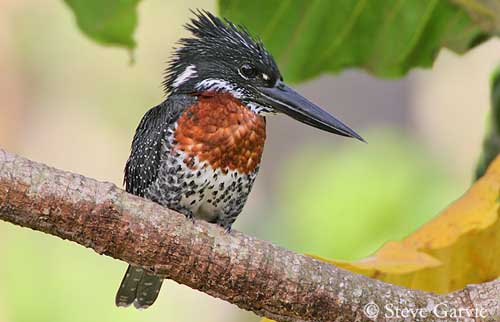
Fr: Martin-pêcheur géant
All : Riesenfischer
Esp : Martín Gigante Africano
Ital: Martin pescatore gigante
Nd: Afrikaanse Reuzenijsvogel
Sd: Jättekungsfiskare
Photographers:
Didier Buysse
Vision d’Oiseaux
Steve Garvie
RAINBIRDER Photo galleries
Ingo Waschkies
My bird pictures on Pbase
Callie de Wet
GALLERY
Text by Nicole Bouglouan
Sources:
HANDBOOK OF THE BIRDS OF THE WORLD Vol 6 by Josep del Hoyo-Andrew Elliott-Jordi Sargatal - Lynx Edicions, 2001 - ISBN: 848733430X
BIRDS OF AFRICA SOUTH OF THE SAHARA by Ian Sinclair and Peter Ryan - Princeton University Press Princeton and Oxford - ISBN: 0691118159
ROBERTS BIRDS OF SOUTH AFRICA by G. R. Mc Lachlan and R. Liversidge – The Trustees of the John Voelcker Bird Book Fuund – ISBN: 0620031182
BIRDS OF THE GAMBIA AND SENEGAL by Clive Barlow and Tim Wacher – Helm Field guides – ISBN: 0713675497
BirdLife International (BirdLife International)
Wikipedia, the free encyclopaedia
Giant Kingfisher
Megaceryle maxima
Coraciforme Order – Alcedinidae Family
BIOMETRICS:
Length: 42-46 cm
Weight: M: 275-425 g – F: 255-398 g
DESCRIPTION:
The Giant Kingfisher is the largest of Africa.
The adult male has dark grey upperparts with white-edged feathers, creating barred and streaked effect. The tail is dark grey-brown with narrow white bars.
On the underparts, chin and throat are white. The breast is rich chestnut with faint darker barring. The belly is white with dark grey bars. The underwing-coverts are white.

On the head, face and hindneck are dark grey to blackish, finely spotted white. Lores and ear-coverts are black with small white loral spot. The cheeks are darker, but the lower part of the head side is white, with two white spots on the lower nape. The crown exhibits a conspicuous stiff shaggy crest, made with black, white-spotted feathers.
The long, heavy beak is greyish-black. The eyes are dark brown. Legs and feet are grey.
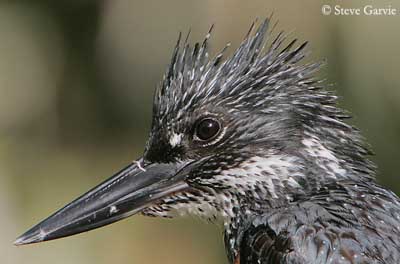
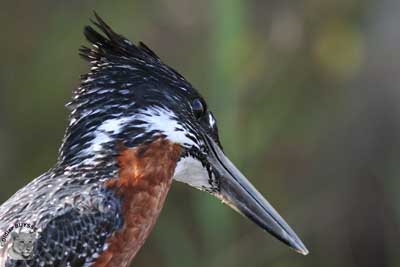
The adult female has similar upperparts, but she has white breast densely spotted black. Belly, flanks, undertail and underwing-coverts are rich chestnut.
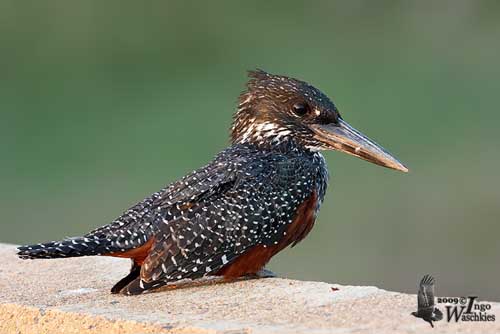
The juvenile male exhibits black speckles on the chestnut breast, and some rufous wash on flanks. The juvenile female resembles adult female, but she has less spotted breast, creating a greyish-white band between breast and belly.
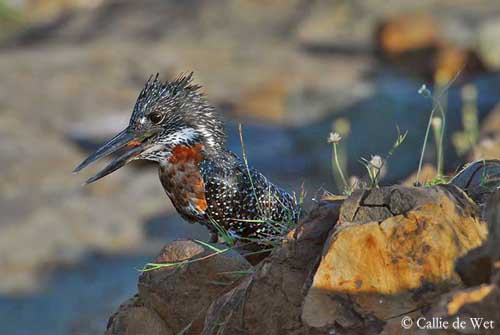
We find two subspecies.
The nominate race M.m. maxima is described above and displayed on this page.
The race M.m. gigantea is darker, with more uniform dark grey upperparts and heavier black barring on the underparts.
VOICE:
The Giant Kingfisher utters loud, harsh cackling when disturbed, giving a single “kek” or repeated “kek-kek-kek”. It also utters softer “kah-kah-kah” as greeting calls, but a rattle “keririririri” can be heard too.
In flight, the bird gives loud, sharp “kakh” and a “kee-ou, kee-kee-ou”.
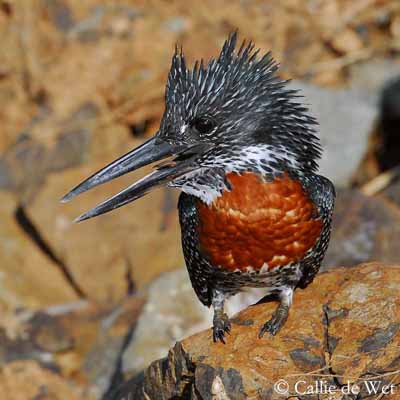
HABITAT:
The race “maxima” is usually found in more open country than “gigantea” which is mostly a rainforest species.
The Giant Kingfisher frequents rivers, streams, lakes, dams and even mountain streams with marginal wooded areas, both in forests and savannahs. It is also found in coastal lagoons, mangroves, estuaries and seashores, and occasionally on stagnant pools along dried-up rivers. It can be seen up to 100 metres from the water. In Tanzania, it may occur up to 1600 metres of elevation.
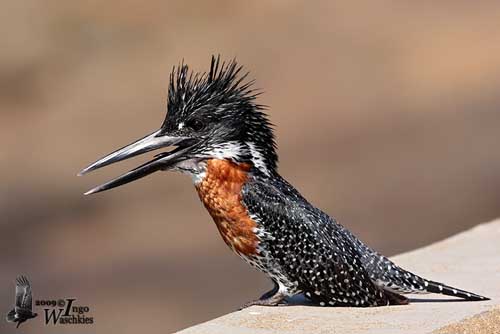
RANGE:
The race “maxima” is found from Senegambia to W Ethiopia and S Angola, N Botswana and South Africa, mainly is the East half, S to Cape Town and SW.
The race “gigantea” occurs in forest from Liberia to N Nigeria, E to W Tanzania and S to N Angola.
BEHAVIOUR:
The Giant Kingfisher feeds mainly on aquatic preys such as fish, river crabs, amphibians and also small reptiles and insects.
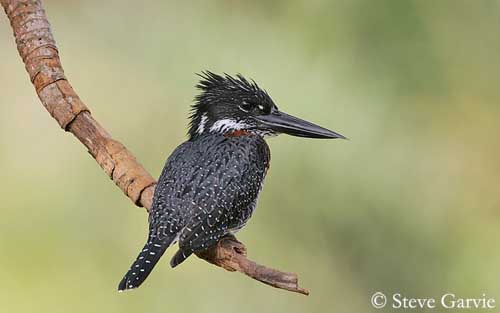
It perches on branch or rock overhanging the water from where it can scans for preys. Then, it dives in steep or shallow dive and disappears underwater to catch the prey, before to return quickly to the same perch. It also may hover above open water, as numerous kingfishers do.
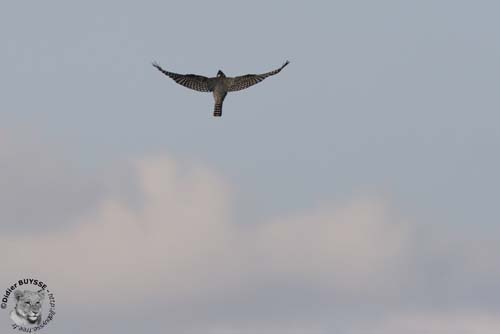
The small crabs are swallowed whole, but the larger are moved to the bill tip and hit on the perch with swinging movements, and there, carapace and pincers are removed before the bird swallows the flesh. Fishes are usually swallowed head first.
The Giant Kingfisher changes of perch after a successful catch. If it fishes in the sea, it will clean its plumage in fresh water.
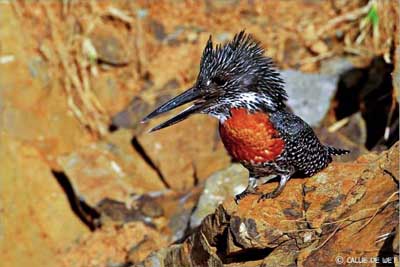
As numerous kingfishers, it is territorial and defends its territory. It is monogamous. The courtship displays are not described, but this species probably performs aerial flights accompanied by calling, some postures by the male to enhance the plumage pattern, and courtship feeding to female.
The Giant Kingfisher is mainly resident in its range, only performing local movements according to the water levels, and the juveniles perform post-breeding dispersion.
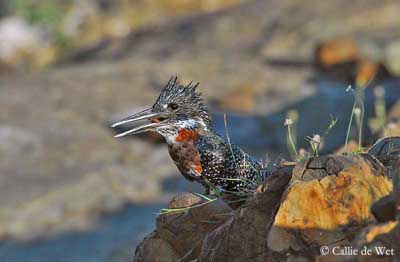
FLIGHT:
The Giant Kingfisher has strong flight and it moves freely across dry brushy areas from a feeding ground to another one.
REPRODUCTION:
The breeding season varies according to the range.
The Giant Kingfisher is solitary nester. The nest is a tunnel excavated by both adults during one week with bill and feet. The tunnel is about 180 cm long and 9-15 cm wide. The nest-chamber at the end is unlined, with 20-60 cm in diameter.
The nest is located in river bank, cliff or sand quarry. The entrance is often concealed behind overhanging vegetation and well above the water level.
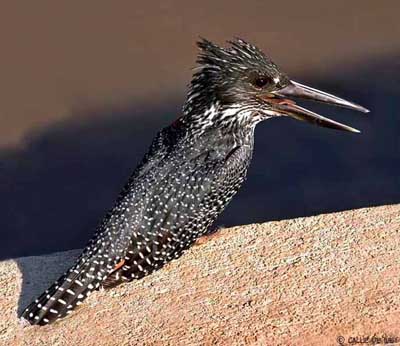
The female lays 3-5 eggs and both adults incubate, but the period is unknown. They take turns 3-4 times a day. After hatching, the male removes the eggs hells. The chicks are fed with fish several times a day. The male stops to feed them after one month, and the female five days later. The young fledge at 37 days, and are able to dive within a few hours, but the female feeds them during three weeks more.
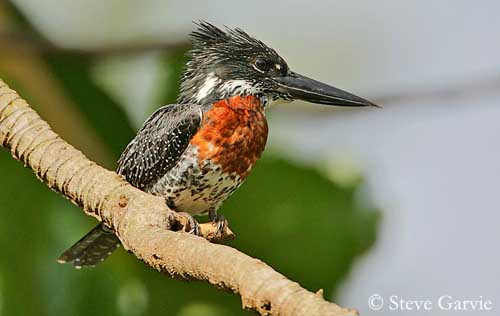
DIET:
The Giant Kingfisher feeds mainly on fish, river crabs, frogs, toads, and occasionally on small reptiles and insects.
This species is very well adapted to several types of habitats.
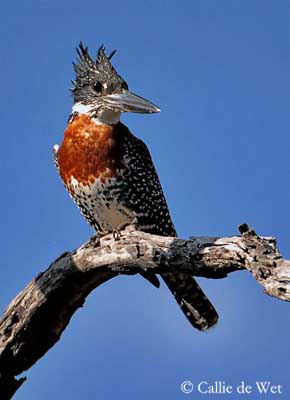
PROTECTION/THREATS/STATUS:
The Giant Kingfisher is locally common and widespread, but it may be threatened by pesticides in water near farmland. It is also considered a pest at fish hatcheries.
The species is evaluated as Least Concern by Birdlife International.